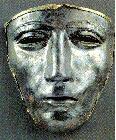 The 'Limes Giant' Mask Found at Kalkriese |
Clades Variana
(The Varus Disaster) By Kevin Barry |
| <<< Previous Next >>> |
Page 4
The News Reaches Rome:
Eventually (and bad news does travel fast), word of the disaster reached Rome and the emperor Augustus.
From Suetonius, "The Divine Augustus" 1:23
Upon receiving intelligence of this disaster, he gave orders for keeping a strict watch over the city, to prevent any public disturbance, and prolonged the appointments of the prefects in the provinces, that the allies might be kept in order by experience of persons to whom they were used. He made a vow to celebrate the great games in honour of Jupiter Optimus Maximus, if he would be pleased to restore the state to more prosperous circumstances. This had formerly been resorted to in the Cambrian and Marian wars. In short, we are informed that he was in such consternation at this event, that he let the hair of his head and beard grow for several months, and sometimes knocked his head against the door-post, crying out, O, Quintilius Varus! give me back my legions! And ever after he observed the anniversary of this calamity, as a day of sorrow and mourning.
Never again did the Romans make a serious attempt to conquer the tribes of northern Germany. They were content to retire to the natural defense of the Rhine and declare it as part of the border between Rome and the barbarians to the north. Before his death, Augustus left a cautionary bequest to the future emperor Tiberius, "Be satisfied with the status quo and supress any desire to increase the size of the empire to a greater size".
The Years After:
Time passes and so do great emperors. The year 14 AD marked the end of the reign of Augustus and the rise of Tiberius.
In 15 AD, 6 years after the battle, the Rhine was crossed once again. This time with Germanicus, the adopted son of Tiberius, at the head of a Roman army with 8 full legions. The purpose of this expedition was to punish Arminius of the Cherusci and the other German tribes that took part in the attack and retrieve the legionary eagles. As far as punishing the Germans was concerned, the first expedition was inconclusive. There are indications that the German tribes held the upper hand in most of the 15 AD battles. However, a detachment of soldiers led by Lucius Stertinius did recover the eagle of Legiond XIX after a battle with the Bructeri. A second eagle, legion unknown, was also recovered by Germanicus. (The third eagle was finally returned to Rome almost 30 years later.)
During this period, Germanicus uncovered the site of the last stand of Varus and his doomed legions.
From Cornelius Tacitus, "The Annals", Book 1:61
In the centre of the field were the whitening bones of men, as they had fled, or stood their ground, strewn everywhere or piled in heaps. Near, lay fragments of weapons and limbs of horses, and also human heads, prominently nailed to trunks of trees. In the adjacent groves were the barbarous altars, on which they had immolated tribunes and first-rank centurions. Some survivors of the disaster who had escaped from the battle or from captivity, described how this was the spot where the officers fell, how yonder the eagles were captured, where Varus was pierced by his first wound, where too by the stroke of his own ill-starred hand he found for himself death.
After several battles, the Romans retired to their winter camp to wait for better weather to try again. In 16 AD Germanicus attempted to bring the Germans to battle and this time the Cherusci made a mistake. Eager for battle and against the advice of Arminius, they allowed the Romans to choose a place that was open and suited to the Roman style of warfare. During the fight, Arminius was possibly wounded and finally withdrew. The remaining tribes were slaughtered with no quarter given.
Arminius died a few years later at the age of 37, either the victim of tribal warfare or at the hands of his kinsmen. The most likely date of his death was 19 AD.
Numismatic Recoveries:
Up until recently, a small number of gold and silver coins had been found in the areas considered the most likely candidates for the battle(s). But one key type was conspicuously absent in all of the finds, the bronzes that would have made up the bulk of the 'small change' likely to be carried by the soldiers. This lack of bronze coinage was considered by some to be proof that the battle did not take place in the Teutobuger Wald.
That changed in 1990 when bronze coins started to be found in the Osnabruck and Kalkriese areas. A large part of the finds (93%) were Augustan Asses with the 'Altar at Lugdunum' reverse. Of these coins, 96% carry countermarks with the 'IMP' (Imperator) being the most common at 50% of the total. In addition there are 'AVG' counterstamps (Augustus), 'VAR' (Quintilius Varus) and 'CVAL' (C. Numonius Vala, cavalry prefect under Varus). The counterstamps of Varus and Vala can only date from 7 AD to 9 AD which indicates that the coins were used to pay his legions and helps to pinpoint the area of battle.
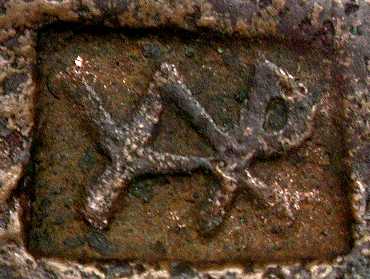
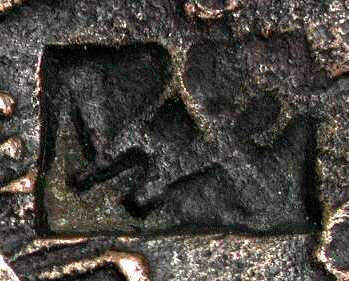
The countermark of Varus is very distinctive, being a ligature form of 'VAR' the first three letters of the Varus name. The images above shows several asses with the countermark. Note that the countermarks occur on both the obverse and reverse. In the case of the 2 examples of a reverse countermark it has been carefully placed between the outstretched arms of the 2 Victories on either side of the altar. On the other hand, the obverse countermarks show a rather careless placement on the imperial portrait.
Two different hands? Or does that signify a change in attitude towards Augustus?
Until the end of 1999, 3 gold, 512 silver coins (162 denarii in one hoard) and 354 copper coins as well as 369 other pieces was recovered with metal detectors. Most of the coins were found in the area of Kalkriese and Osnabrueck. As of August, 2000 1408 coins have been found, including 23 aureii, 758 denarii and 627 asses.
The 758 silver coins represent a cross section of the types that were in circulation at the turn of the first century AD. This includes Roman Republic, old Mark Antony legionary denarii and the latest dated coin (3-4 AD) which was the Augustus 'Gaius and Lucius' Caesar denarius. The most common type, at 158 coins, was the Augustus Gaius and Lucius Caesar Denarius. Also found was at least one Roman Republic C. Egnatuleius C.f. quinarius and several fourres.
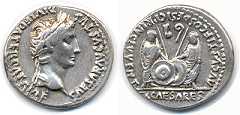
Augustus Gaius and Lucius Caesar Denarius
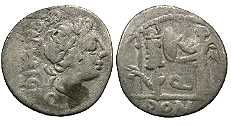
C. Egnatuleius C.f. AR Quinarius
The 23 aurei include several extremely rare examples such as a C. Antistius Vetus aureus and Augustan 'QVO D.VIAE.MVN.SVNT.' Aureaus.
The News Reaches Rome:
Eventually (and bad news does travel fast), word of the disaster reached Rome and the emperor Augustus.
From Suetonius, "The Divine Augustus" 1:23
Upon receiving intelligence of this disaster, he gave orders for keeping a strict watch over the city, to prevent any public disturbance, and prolonged the appointments of the prefects in the provinces, that the allies might be kept in order by experience of persons to whom they were used. He made a vow to celebrate the great games in honour of Jupiter Optimus Maximus, if he would be pleased to restore the state to more prosperous circumstances. This had formerly been resorted to in the Cambrian and Marian wars. In short, we are informed that he was in such consternation at this event, that he let the hair of his head and beard grow for several months, and sometimes knocked his head against the door-post, crying out, O, Quintilius Varus! give me back my legions! And ever after he observed the anniversary of this calamity, as a day of sorrow and mourning.
Never again did the Romans make a serious attempt to conquer the tribes of northern Germany. They were content to retire to the natural defense of the Rhine and declare it as part of the border between Rome and the barbarians to the north. Before his death, Augustus left a cautionary bequest to the future emperor Tiberius, "Be satisfied with the status quo and supress any desire to increase the size of the empire to a greater size".
The Years After:
Time passes and so do great emperors. The year 14 AD marked the end of the reign of Augustus and the rise of Tiberius.
In 15 AD, 6 years after the battle, the Rhine was crossed once again. This time with Germanicus, the adopted son of Tiberius, at the head of a Roman army with 8 full legions. The purpose of this expedition was to punish Arminius of the Cherusci and the other German tribes that took part in the attack and retrieve the legionary eagles. As far as punishing the Germans was concerned, the first expedition was inconclusive. There are indications that the German tribes held the upper hand in most of the 15 AD battles. However, a detachment of soldiers led by Lucius Stertinius did recover the eagle of Legiond XIX after a battle with the Bructeri. A second eagle, legion unknown, was also recovered by Germanicus. (The third eagle was finally returned to Rome almost 30 years later.)
During this period, Germanicus uncovered the site of the last stand of Varus and his doomed legions.
From Cornelius Tacitus, "The Annals", Book 1:61
In the centre of the field were the whitening bones of men, as they had fled, or stood their ground, strewn everywhere or piled in heaps. Near, lay fragments of weapons and limbs of horses, and also human heads, prominently nailed to trunks of trees. In the adjacent groves were the barbarous altars, on which they had immolated tribunes and first-rank centurions. Some survivors of the disaster who had escaped from the battle or from captivity, described how this was the spot where the officers fell, how yonder the eagles were captured, where Varus was pierced by his first wound, where too by the stroke of his own ill-starred hand he found for himself death.
After several battles, the Romans retired to their winter camp to wait for better weather to try again. In 16 AD Germanicus attempted to bring the Germans to battle and this time the Cherusci made a mistake. Eager for battle and against the advice of Arminius, they allowed the Romans to choose a place that was open and suited to the Roman style of warfare. During the fight, Arminius was possibly wounded and finally withdrew. The remaining tribes were slaughtered with no quarter given.
Arminius died a few years later at the age of 37, either the victim of tribal warfare or at the hands of his kinsmen. The most likely date of his death was 19 AD.
Numismatic Recoveries:
Up until recently, a small number of gold and silver coins had been found in the areas considered the most likely candidates for the battle(s). But one key type was conspicuously absent in all of the finds, the bronzes that would have made up the bulk of the 'small change' likely to be carried by the soldiers. This lack of bronze coinage was considered by some to be proof that the battle did not take place in the Teutobuger Wald.
That changed in 1990 when bronze coins started to be found in the Osnabruck and Kalkriese areas. A large part of the finds (93%) were Augustan Asses with the 'Altar at Lugdunum' reverse. Of these coins, 96% carry countermarks with the 'IMP' (Imperator) being the most common at 50% of the total. In addition there are 'AVG' counterstamps (Augustus), 'VAR' (Quintilius Varus) and 'CVAL' (C. Numonius Vala, cavalry prefect under Varus). The counterstamps of Varus and Vala can only date from 7 AD to 9 AD which indicates that the coins were used to pay his legions and helps to pinpoint the area of battle.
 |
 |
 |
Augustan Asses With Varus Countermark On Obverse
© Roman Numismatic Gallery www.roman-coins.yucom.be
© Roman Numismatic Gallery www.roman-coins.yucom.be
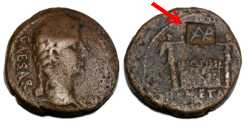 |
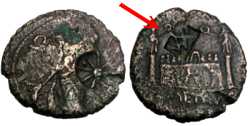 |
Augustan Asses With Varus
Countermark On Reverse
Countermark On Reverse


Close-up Of Varus Countermarks
The countermark of Varus is very distinctive, being a ligature form of 'VAR' the first three letters of the Varus name. The images above shows several asses with the countermark. Note that the countermarks occur on both the obverse and reverse. In the case of the 2 examples of a reverse countermark it has been carefully placed between the outstretched arms of the 2 Victories on either side of the altar. On the other hand, the obverse countermarks show a rather careless placement on the imperial portrait.
Two different hands? Or does that signify a change in attitude towards Augustus?
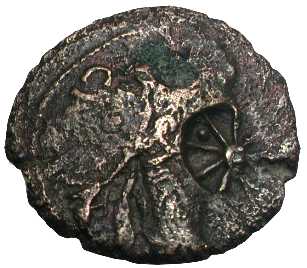 |
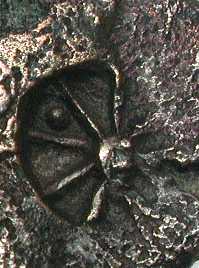 |
Third, Unknown Countermark
Until the end of 1999, 3 gold, 512 silver coins (162 denarii in one hoard) and 354 copper coins as well as 369 other pieces was recovered with metal detectors. Most of the coins were found in the area of Kalkriese and Osnabrueck. As of August, 2000 1408 coins have been found, including 23 aureii, 758 denarii and 627 asses.
The 758 silver coins represent a cross section of the types that were in circulation at the turn of the first century AD. This includes Roman Republic, old Mark Antony legionary denarii and the latest dated coin (3-4 AD) which was the Augustus 'Gaius and Lucius' Caesar denarius. The most common type, at 158 coins, was the Augustus Gaius and Lucius Caesar Denarius. Also found was at least one Roman Republic C. Egnatuleius C.f. quinarius and several fourres.

Augustus Gaius and Lucius Caesar Denarius

C. Egnatuleius C.f. AR Quinarius
The 23 aurei include several extremely rare examples such as a C. Antistius Vetus aureus and Augustan 'QVO D.VIAE.MVN.SVNT.' Aureaus.
| <<< Previous Next >>> |